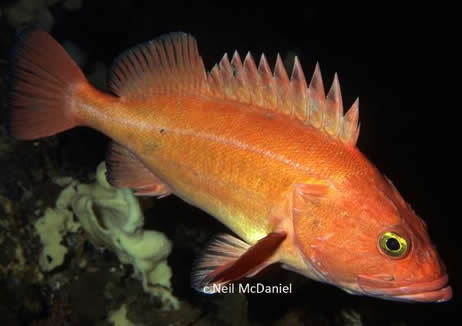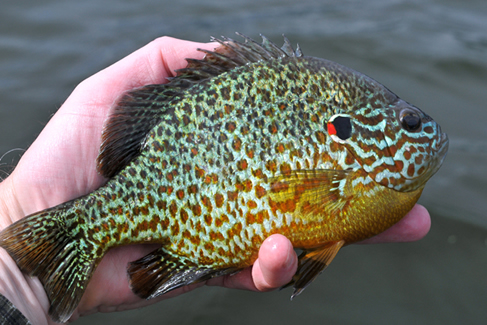

AN INTRODUCTION TO THE FISHES OF BRITISH COLUMBIA

Yelloweye Rockfish (Sebastes ruberrimus), photo by Neil McDaniel
by
Eric Taylor
Professor, Department of Zoology, University of British Columbia
Director, Beaty Biodiversity Museum
The fishes of British Columbia are an extremely diverse and interesting wildlife group. With 67 native and 15 or so introduced species of freshwater fishes and 409 native species of marine fishes, British Columbia boasts a fish fauna much richer than most provinces in Canada. A simple count of named species as a measure of diversity, however, does not tell the true story of BC’s diversity of fishes. First, many species are endemic to BC; that is, they occur nowhere else in Canada. Second, BC, owing to its mountainous terrain and a mix of freshwater and marine habitats, possesses myriad genetically distinct populations within species (including several thousand distinct populations of Pacific salmon and trout). In addition, some “species complexes” comprise genetically distinct populations living together that act as distinct biological species, but have not yet been named as such (e.g., BC’s world famous “species pairs” of threespine sticklebacks). Some fish species are found both in freshwater and saltwater during different phases of their lives (these are called “diadromous” fishes). Fishes that reproduce in fresh water, but may live for variable, but typically extensive, time periods in marine waters are called “anadromous” fishes (e.g., Pacific salmon, various species of smelts, white sturgeon). Fishes that reproduce in marine waters, but which may feed and grow for variable time periods in freshwater habitats are called “catadromous” fishes (e.g., American eel), but there are no catadromous fishes in BC waters. Some fishes that reproduce in fresh water, but make brief forays to the sea for feeding are sometimes referred to as “amphidromous” fishes (e.g., bull trout on BC’s south coast, prickly sculpin). Among the most biologically interesting fish species found here are the trout and salmon.
While important to commercial, recreational, and Aboriginal fisheries in BC, these fishes also have interesting life cycles and biology. Some species, such as the rainbow trout (Oncorhynchus mykiss) and the coastal cutthroat salmon (Oncorhynchus clarkii clarkii), have populations that reside permanently in fresh water as well as populations that enter the sea to feed, but return to freshwater streams to breed (anadromous populations).
Our marine waters are home to several species of sharks. Shark species that have been observed off the coast of BC include seven-gill sharks, lamniform sharks, ground sharks, and dogfish and sleeper sharks. Lamniform sharks include great white sharks (Carcharodon carcharias) and basking sharks (Cetorhinus maximus), two of the largest species of fishes.
While most of our fish species are those that live in temperate climates, there are several subtropical species that appear in BC waters during El Nino years, when warmer waters move northward in the Pacific Ocean. These include the roughback sculpin (Chitonotus pugetensis) and the ocean whitefish (Caulolatilus princeps).
Over the years, several non-native fish species have been introduced into BC, especially in freshwater habitats. These non-native fishes include goldfish (Carassius auratus), common carp (Cyprinus carpio), the oriental weatherfish (Misgurnus anguillicaudatus), and anadromous species such as the Atlantic Salmon (which has been reported spawning in at least one BC river) and the American Shad (Alosa sapidissima). The detrimental effects of non-native fishes from competition, predation, and/or disease transfer, is the second most serious threat (after habitat loss and degradation) to the persistence of our native freshwater fishes.

Pumpkinseed (Lepomis gibbosus), photo by Ian Gardiner
Explore the E-Fauna BC fish atlas pages to learn more about marine and freshwater fishes in BC, about which species are introduced, and about each species biology and distribution, and conservation. You can access the atlas pages by typing in "fish" in the common name box in either our Quick Search feature on the home page, or in the Species Search page.
Please cite these pages as:
Author, date, page title. In: Klinkenberg, Brian. (Editor) 2021. E-Fauna BC: Electronic Atlas of the Fauna of British Columbia [www.efauna.bc.ca]. Lab for Advanced Spatial Analysis, Department of Geography, University of British Columbia, Vancouver. [Date Accessed]
© Copyright 2021 E-Fauna BC.